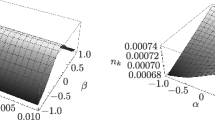Summary
Free spin-1/2 particles in an expanding isotropic and homogeneous universe are treated in the framework of the quantum mechanics of unquantized matter fields. The curved space-time acts thereby as an unquantized external field. The eigenvalues of energy and momentum are time dependent. They are, after a simultaneous energy and momentum measurement, related by the special-relativistic relationE(t) = = ±c √p 2(t) +m 2 c 2. A freely moving plane wave (solution of the dynamical equation which is an eigenfunction of the momentum) contains in general cigenfunctions of both signs of the energy, which in special relativity remain decoupled. This is also the case in the universe above for particles with vanishing rest mass (neutrinos) and massive particles with vanishing momentum. For other particles one finds an expansion-induced time-dependent mixing of positive- and negative-energy parts. One can interpret this with regard to the corresponding creation and annihilation operators of quantum field theory as the analogue of particle production. The probability of finding particles of opposite sign of the energy differs with the aget of the universe and is of the order ϱ(t), where ϱ(t) isħ/mc 2 times the Hubble parameter at the timet. For electrons ϱ(t) ≈ 10-21 t -1 s. While ϱ(t) is today only about 10-39, one can expect considerable particle production for times with ϱ(t) ≥ 1, i.e. during the first 10-21 seconds of the Universe.
Riassunto
Si trattano partioelle libere di spin 1/2 in un universo isotropo ed omogeneo in espansione nel contesto della meccanica quantistica di campi materiali non quantizzati. Lo spazio-tempo curvo vi agisce come un campo esterno non quantizzato. Gli autovalori dell’energia e dell’impulso dipendono dal tempo. Essi, dopo una misura simultanea dell’energia e dell’impulso, sono correlati dalla relazioneE(t) = ±c √p 2(t) +m 2 c 2 della relatività ristretta. Un’onda piana che si muove liberamente (soluzione dell’equazione dinamica che è un’autofunzione dell’impulso) contiene in generale autofunzioni dell’energia di entrambi i segni, le quali nella relatività ristretta rimangono disaccoppiate. Questo è anche il caso nel suddetto universo per particelle con massa in quiete tendente a zero (neutrini) e per particelle con massa con impulso che tende a zero. Per altre particelle si trova una mescolanza di parti di energia positiva e negativa dipendente dal tempo indotta dall’espansione. Si può interpretare ciò rispetto ai corrispondenti operatori di creazione ed annichilazione della teoria quantistica dei campi come l’analogo della produzione di particelle. La probabilità di trovare particelle con segni dell’energia opposti varia con l’età t dell’universo ed è dell’ordine di ϱ(t), che èħ/mc 2 volte il parametro di Hubble al tempot. Per gli elettroni ϱ(t) ≈ 10-21 t -1 s. Mentre ϱ(t) è oggi circa 10-39, ci si può aspettare una considerevole produzione di particelle in tempi con ϱ(t) ≥ 1, cioè durante i primi 10-21 secondi dell’universo.
Резюме
Свободные частицы со спинам половина в расширяющейся изотр опной и однородной Вс елеиной рассматрива ются в рамках квантов ой механики для рассматриваются в ра мках квантовой механ ики для неквантовани ьΙш неквантованиьΙш полей вещества. Искри вленное пространств о-время действует как неквантованное внеш нее поле. Собственные значения энергии и импульса не зависят от времени. Он и, при одновременном и змерении энергии и им пульса, связан одновременном измер ении энергии и импуль са, связаны соотношен ием специальной теор ии относительностиE(t) = ±c √p 2(t) +m 2 c 2. Свободно движущаяся плоская волна (решени е д соотношением специа льной теории относит ельности. Свободно д вижущаяся плоская во лна (решение динамиче ского уравнения, кото рое является собстве нной функцией импуль са) содержит, вообще, со бственные. Свободно движущаяс я плоская волна (решен ие динамического ура внения, которое являе тся собственной функ цией импульса) содерж ит, вообще, собственны е функпии обоих динамического уравн ения, которое являетс я собственной функци ей импульса) содержит, вообще, собственные ф ункпии обоих собственной функцие й импульса) содержит, в ообще, собственные фу нкпии обоих собственные функпии обоих знаков для энергии, ко торые в специальной т еории относительности ост аются несвязанными. Это имеет место также в случае вьппеупомян утой Вселенной для частиц с обращающейся в нуль массой покоя (нейтрин о) и для массивных част иц с щающим покоя (нейтрино) и для м ассивных частиц с щаю щимся в нуль моментом. Для других частиц пол учается разпожение, и ндуцированное нуль моментом. Для дру гих частиц получаетс я разпожение, индуцир ованное разпожение, индуциро ванное зависящим от времени смешиванием частей с положительной и отри цательной энергиями. Это можно и нтерпретировать с по мощью соответствующих опе раторов рождения и ун ичтожения квантовой теории поля, как анало г рождения квантовой теории пол я, как аналог рождения частиц. Вероятность о бнаружения частиц противоположного зн ака энергии изменяет ся с возрастом t Вселеино й и составляет величи ну порядка (i), где ϱ(t) есть ħmc2, умножен ная на параметр Хуббл а в момент времени t. Дл я электронов ϱ(t) момент времени t. Для эл ектронов ϱ(t) 1021t’ сех. Хотя ϱ(t) сегодня с оставляет около 10З9, мо жно ожидать значительно го рождения частиц дл я времен с ϱ(t) 1, т.е. в течен ие первых 10-21 секунд 1, т.е. в течение первых 10-21 с екунд Вселенной.
Similar content being viewed by others
Author information
Authors and Affiliations
Additional information
Part of this work has been carried out during the author’s stay at Queen Elizabeth College, University of London.
Rights and permissions
About this article
Cite this article
Audretsch, J. Quantum-mechanical analogue of particle creation caused by the expansion of the universe. Nuovo Cim 17, 284–299 (1973). https://doi.org/10.1007/BF02894673
Received:
Published:
Issue Date:
DOI: https://doi.org/10.1007/BF02894673




